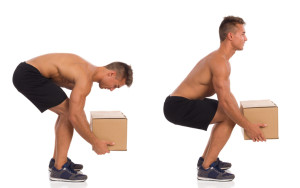Degenerative Disc Pain? Here’s How to Manage It
If the discs between your spinal vertebrae become damaged or suffer wear and tear, degenerative disc pain may result. Here’s what you can do.
Your spine is subjected to immense wear and tear over your lifetime. Fortunately, it comes with its own inbuilt shock absorption system—one that’s designed to counter the forces placed on it by the motion involved in day-to-day life, as well as physical exercise and (often improper) body mechanics. This shock absorption system comes in the form of rubbery discs in between each of the spinal vertebra. If something goes wrong with one or more of them, you could suffer from degenerative disc pain.
What’s Behind Degenerative Disc Pain?
Spinal discs have a tough collagen outer “shell” that protects a softer core composed of looser collagen fibers within a jelly-like substance. Spinal discs remain pliable because their soft core is about 80 percent water.
But as you get older, the discs dehydrate. This makes them stiff and prone to cracking and tearing, particularly if you engage in sports or are not careful about how you use your spine when lifting. Referred to as degenerative disc disease, these cracks and tears can be painful—and because very little blood is supplied to the spinal discs, they are unable to repair themselves.
It’s also possible for the jelly at the center of a cracked disc to bulge out and squeeze one of the nearby nerve roots that branch out from the spinal cord (for example, one common manifestation of degenerative disc pain is sciatic nerve pain that occurs because a bulging disc is compressing the sciatic nerve root). The discomfort you feel can be exacerbated by the fact the jelly interior of the spinal disc contains inflammatory proteins that can further inflame nerve roots if it comes into contact with them.
Is It Degenerative Disc Pain? Symptoms May Tip You Off
If you have the following symptoms, you may be suffering from degenerative disc disease.
- Pain that radiates from the neck to the shoulders, arms, hands and fingers, or from the lower back to the buttocks, and thighs.
- Pain that is more severe when you are sitting down, bending, twisting, and/or lifting, and less severe when you are walking.
- Pain that wakes you from sleep when you change positions in bed.
- Numbness, pins and needles, and weakness in your extremities.
If you have any of these symptoms, discuss them with your doctor. Painkillers, heat and cold packs, and physical therapy can help relieve degenerative disc pain by strengthening the muscles that support your spine.
It also is important not to overtax your spine by lifting heavy items (and if lifting, don’t bend at the waist—bend at the knees, hold the item close to your body, and push upright). Also, lose weight if you’re overweight or obese, eat a healthful diet, and quit smoking.
“There are more and more high-quality studies coming out that show an association between healthy lifestyle and improved quality and quantity of life, as well as better disease management,” says Dr. Mitchel Leavitt, MD, resident physician at Emory University’s Department of Physical Medicine and Rehabilitation. “Spine health is no different.”

Give your back a break: Avoid lifting objects while bending over from the waist, as pictured on the left. Proper form is at right: Bend at the knees so your legs do more of the “heavy lifting.”
Common in Seniors
It is thought that by about age 60, most people have some degree of degenerative disc disease, though they may not suffer from degenerative disc pain. If and when pain develops, it can become chronic, and can affect the upper portion of the spine (called the cervical spine) as well as the lower (or lumbar) spine.
Research carried out at Loyola Medicine’s Pain Management Center suggests that women may be slightly more likely to suffer from degenerative disc pain in the lower back and the neck. The study, reported at the American Academy of Pain Medicine annual meeting in March 2016, included 3,337 patients, showed that women are 1.38 times more likely to report neck pain due to cervical degenerative disc disease.
Another recent study, presented at the Association of Academic Physiatrists‘ annual meeting in February 2016, suggests that smoking could make you more vulnerable to degenerative disc pain that radiates out from the neck to the shoulders, arms, and hands.
Previous studies have found a link between smoking and degenerative disc pain in the lower back, but this is the first study to find an association with neck pain.
“Smoking is not healthy for a person’s intervertebral discs, given the risk of developing microvascular disease—a disease of the small blood vessels—due to nicotine abuse,” says the study’s lead author, Mitchel Leavitt, MD, resident physician at Emory University’s Department of Physical Medicine and Rehabilitation. “Intervertebral discs receive their nourishment from the microvasculature that line the endplates on either side of each disc. When these blood vessels are damaged, the discs do not receive nourishment, and this may speed up the degenerative process.”
Originally published in June 2016 and updated.


 Vestibular Migraine Diet
Vestibular Migraine Diet  Bone Spurs on the Spine
Bone Spurs on the Spine  Knee Injections for Osteoarthritis Pain Relief
Knee Injections for Osteoarthritis Pain Relief 
Pictured: Diagram showing a degenerative disc along with a bulging disc.
© Designua | Dreamstime.com